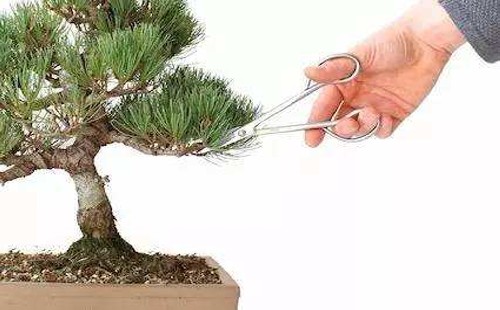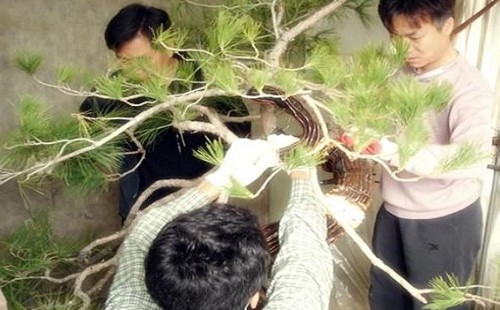When and how to trim the pine bonsai
Pine bonsai is a common variety in bonsai art creation, but it often shows people a positive spirit with its elegant image and upright temperament. It is precisely because the pine tree's perfect external image and tough internal temperament combine to give full play to its own advantages, so many bonsai creators like to use it as material.

In order to make the pine bonsai have and maintain a beautiful tree shape for a long time, improve the ventilation and light transmission effect of the tree, and at the same time improve the ability to resist diseases and insect pests, pruning means often play a very important role in the process of maintenance and management. So, when will the pine bonsai be trimmed? How do you trim it?
The pruning of pine bonsai is mostly carried out in autumn, and sometimes it can last until February of the following spring, but it generally needs to be combined with modeling needs to implement. Under normal circumstances, the shoots from the autumn buds and summer buds germinated in the previous year should not be pruned, but should be preserved as much as possible, but the old leaves that had grown before the previous year should be properly cut off. And bonsai pine trees should be roughly cut and shaped in time after being finalized, and at the same time promote the natural germination and growth of its branches.
And the location of the cut that needs to be trimmed is very important, generally not at the headquarters of the branch, but at the part of the branch, so it should be pruned with seedlings. And if the leaves grow too much and too luxuriantly, the leaves growing below the outline should also be reasonably cut off.
Pine bonsai pruning needs to be carried out according to the characteristics of plant shape and modeling needs, the original is mainly a reasonable refinement of the tree type, in order to achieve a more ideal display effect. In particular, the old branches and leaves with poor growth ability should be removed in the process of pruning to improve the permeability of the tree, so as to increase photosynthesis, promote a large number of germination of new branches and leaves, and make bonsai trees moderately maintain youth and vitality.
The pruning of pine bonsai must follow certain rules, and do not cut it blindly, otherwise it is not only not conducive to promote the germination and growth of new branches and leaves, but also may bring great losses. The main purpose of pruning is to refine the plant type to promote growth and improve the ornamental value of bonsai, so it is usually not suitable to take a large number of heavy pruning in the process of pruning.
The pruning of pine bonsai mainly includes bud pruning and pruning. The main purpose of bud cutting is to cut off the excessively long and protruding bud tip on the top tip of the bonsai tree, and the cut part should account for 1 prime 3-1 thumb 2 of the whole branch. By cutting off the terminal buds, the needles can grow more luxuriantly and shorter, while the branches will be thickened. On the contrary, if it is not pruned in time for a long time and is allowed to grow freely, it will inevitably affect the beauty of the plant type, because the distribution of branches and leaves is more natural and messy, and the tree potential will become weaker, and the ornamental nature of bonsai will be greatly reduced.
Pruning can last from the end of autumn in the previous year to February in the following spring, because the pine trees during this period are basically dormant and are more suitable for pruning. During this period, it is mainly to cut off the branches in the form of growing branches, messy branches, old, weak, sick and disabled branches. For large branches, if a large wound is formed after pruning or truncation, it is necessary to seal the wound with adhesive tape in time to prevent excessive exosmosis of tree sap and cause damage to the plant.
However, from the perspective of the beauty of bonsai, pruning needs to be combined with plastic arts. In the process of pruning, we should take natural posture, proper trade-off and reasonable layout as the principle, so as to create elegant pine bonsai. Therefore, the requirements for bonsai creators are relatively high, not only to have skilled pruning techniques, but also to have a relatively deep artistic foundation, requiring creators to know what they know at any time.
Time: 2019-06-07 Click:
- Prev

The mode of reproduction of Selaginella officinalis
Selaginella officinalis not only has outstanding medicinal effect, but also has a certain ornamental value. If it is made into a bonsai, the ornamental effect is quite good. If you want to get potted seedlings, there are many ways of reproduction. However, different methods of reproduction require different methods of operation.
- Next

The method of bending the branches of Elm Bonsai
Taking the bend is a modeling method often used in the creation of bonsai works, and we need to master certain skills before the operation, otherwise it may lead to failure and cause loss to the branches, thus weakening the tree potential and affecting the ornamental value at the same time.
Related
- Fuxing push coffee new agricultural production and marketing class: lack of small-scale processing plants
- Jujube rice field leisure farm deep ploughing Yilan for five years to create a space for organic food and play
- Nongyu Farm-A trial of organic papaya for brave women with advanced technology
- Four points for attention in the prevention and control of diseases and insect pests of edible fungi
- How to add nutrient solution to Edible Fungi
- Is there any good way to control edible fungus mites?
- Open Inoculation Technology of Edible Fungi
- Is there any clever way to use fertilizer for edible fungus in winter?
- What agents are used to kill the pathogens of edible fungi in the mushroom shed?
- Rapid drying of Edible Fungi

